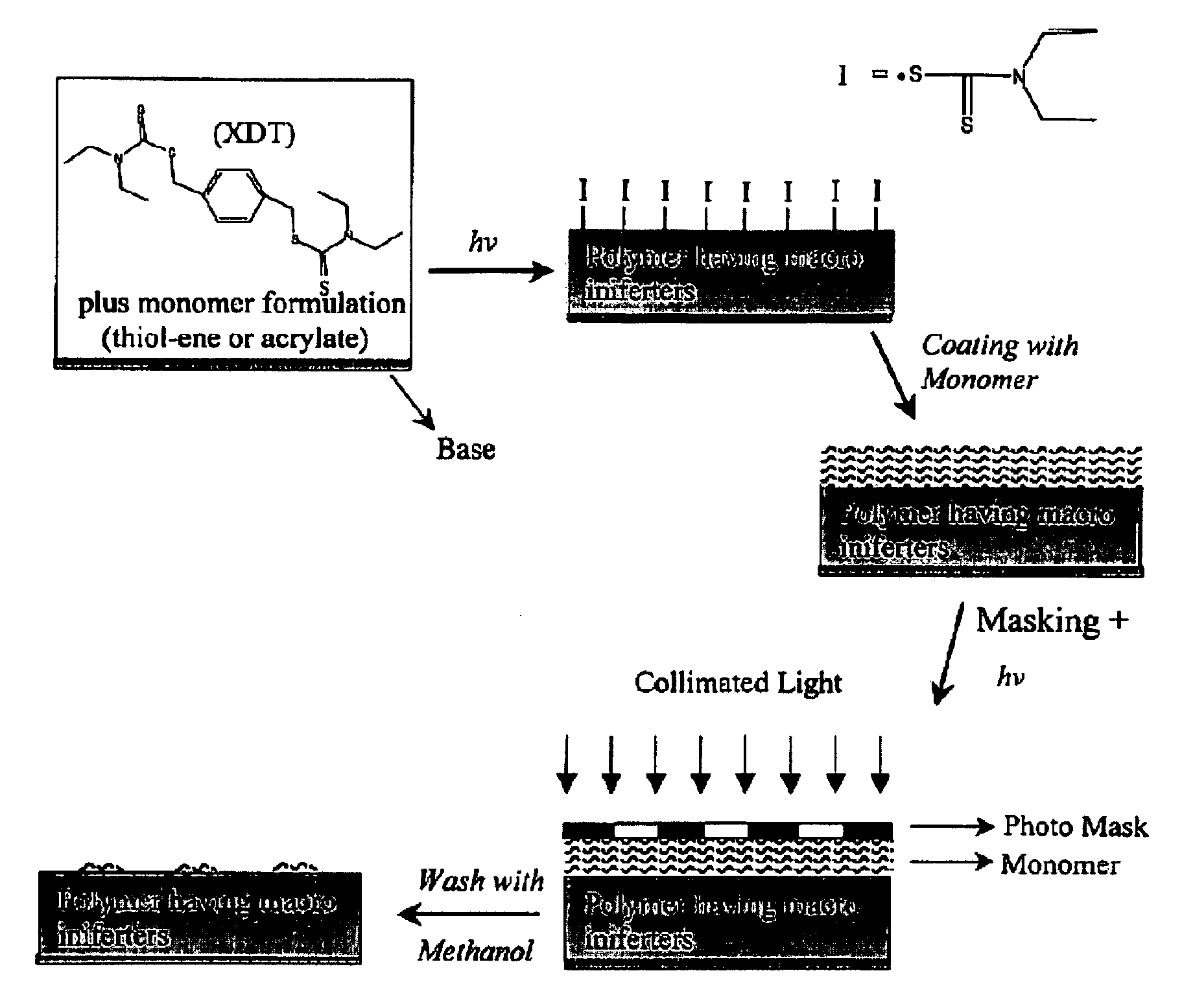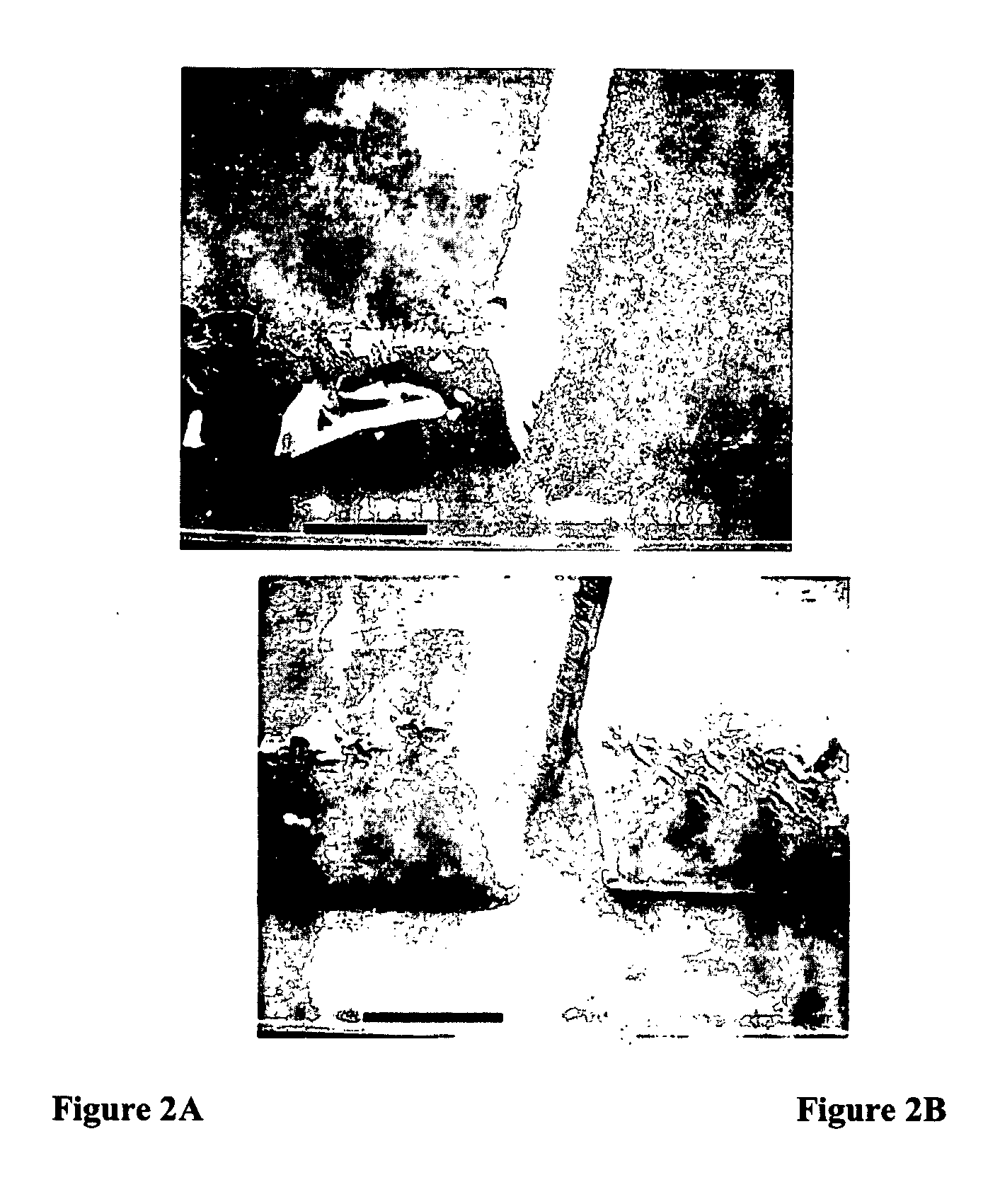Photolytic Polymer Surface Modification
a surface modification and polymer technology, applied in the field of photolysis polymer surface modification, can solve the problems of poor mechanical integrity, limited utility as a device material, lack of robust surface modification techniques, etc., and achieve the effect of high glass transition temperature and low shrinkage stress
- Summary
- Abstract
- Description
- Claims
- Application Information
AI Technical Summary
Benefits of technology
Problems solved by technology
Method used
Image
Examples
example 1
[0096]This example illustrates a comparative photopatterning study of polymers derived from a mixture of monomers that does not contain any thiol monomer and polymers derived from a mixture of monomers that comprises a thiol monomer in accordance with the present invention.
[0097]Two-dimensional polymeric structures formed from a urethane acrylate monomer formulation are shown in FIG. 2. The formulation for FIG. 2 consists of a 50:50 mixture of Ebecryl 4827 aromatic urethane diacrylate (Surface Specialties, UCB) and SR272* triethylene glycol diacrylate (Sartomer) with 1.5 wt % Irgacure 184 (Ciba Geigy) and 1.0 wt % tetraethylthiuram disulfide (TED) (Aldrich). It is believed that the structures in FIG. 2 are ridged due to shrinkage stress and bowed outwards at the base of the structures. These features are common in photopatterned structures derived from methacrylate monomer systems due to shrinkage stress and oxygen inhibition.
[0098]Polymerization of thiol monomer and acrylate monome...
example 2
Formation of Reactive Substrates
Thiol-Olefin Polymers Versus Acrylate Polymers
[0101]Experiments were conducted to investigate the curing kinetics of typical thiol-olefin polymers in the presence of photoiniferters and compared with those of typical acrylate and methacrylate polymerization rate under similar conditions. FIG. 5 shows the rate of various polymerization reactions in the presence of 0.5 wt % XDT, and at an irradiation intensity of 5 mW / cm2. In FIG. 5, (- -) shows the polymerization rate of pentaerythritol tetra-(3-mercaptopropionate)-triethylene glycol divinyl ether mixture; (——) shows the polymerization rate of pentaerythritol tetra-(3-mercaptopropionate)-Vectomer 5015 vinyl ether mixture; (∘) shows the polymerization rate of triethyleneglycol diaciylate; and (□) shows the polymerization rate of triethyleneglycol dimethacrylate.
[0102]As shown in FIG. 5, in the presence of XDT, the polymerization rate of mixtures comprising a thiol monomer was one to two orders of magnit...
example 3
[0103]Polymerization rate of monomer compositions of the present invention are significantly less sensitive to oxygen inhibition. FIG. 6 is a graph showing the conversion (i.e., polymerization) versus time profiles for thiol-DVE3 and TEGDA systems containing 0.5 wt % XDT in the presence of air. Both samples were polymerized at an intensity of 5 mW / cm2. In FIG. 6, (—) shows the rate of thiol-DVE3 polymerization and (——) shows the rate of TEGDA polymerization. As can be seen, while the thiol-olefin monomer composition cures rapidly even in the presence of air, TEGDA shows significantly reduced conversion under these conditions.
PUM
| Property | Measurement | Unit |
|---|---|---|
| glass transition temperature | aaaaa | aaaaa |
| glass transition temperature | aaaaa | aaaaa |
| height | aaaaa | aaaaa |
Abstract
Description
Claims
Application Information
 Login to View More
Login to View More - R&D
- Intellectual Property
- Life Sciences
- Materials
- Tech Scout
- Unparalleled Data Quality
- Higher Quality Content
- 60% Fewer Hallucinations
Browse by: Latest US Patents, China's latest patents, Technical Efficacy Thesaurus, Application Domain, Technology Topic, Popular Technical Reports.
© 2025 PatSnap. All rights reserved.Legal|Privacy policy|Modern Slavery Act Transparency Statement|Sitemap|About US| Contact US: help@patsnap.com



